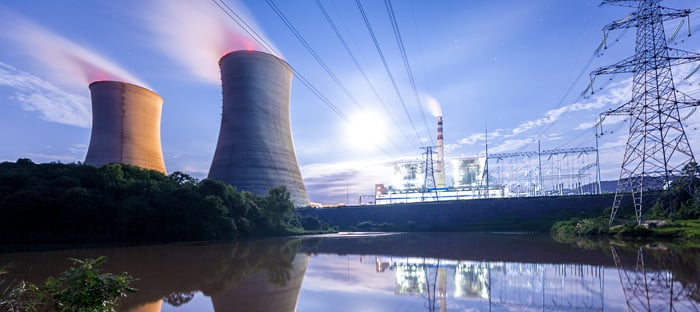Power your home
Enjoy price security with Safe Harbor fixed price energy plans

Power your business

Loading component...
Loading component...
Energy Resources

Across industries and around the world, organizations large and small are joining the fight to halt climate change through a commitment to balance or eliminate their carbon emissions by 2050. While climate-related policy change is a big driver for most organizations, altruism plays a role as well. So does inevitability, as climate science reveals new information about the possible effects of rising temperatures.
While it’s an easy commitment to make for all those reasons, obtaining net zero goals presents a serious challenge for a lot of companies. This is particularly true for carbon-intensive energy companies and financial services organizations, which manage portfolio emission, over which they have little control.
One solution for challenged organizations is to “trade” their carbon emissions production for an equal or greater carbon emissions reduction, ostensibly creating a net carbon emission rate of zero, or net zero. While the concept might sound esoteric, the effort works because carbon emissions mix within the atmosphere and can travel ample distances. It doesn’t matter where the emissions occur – only that they do. Thus, the concept works, and is achieved through the purchase of carbon offsets.
If your organization is ready to learn more, the following guide will help you strategically discover, select, and purchase carbon offsets.
Most companies exploring carbon offsets know they are a “shift of one’s own carbon emissions elsewhere,” as described by Capital Monitor. The shift occurs with the purchase of carbon credits, each representing a metric ton of carbon either removed from the atmosphere via carbon storage – which includes the simple act of planting trees – or avoided through an emissions reduction project. Carbon offsets are typically government certified, though independent certification organizations can also do so.
When a company buys an offset credit, it can use that credit toward its carbon emissions reduction goals. The strategy is far more budget-friendly for companies that would otherwise have to invest substantially – and, in some cases, prohibitively – in their own business processes to achieve similar goals.
If your organization is considering carbon offsets, know that there are several types to choose from – and not all carbon offsets are the same. Every carbon offset type, however, falls into one of two categories.
Popular with companies and their consumers alike, reforestation and conservation projects provide offset credits by way of the carbon captured by planting new forests and the carbon avoided by retaining older trees. While these programs feel good when bundled into corporate social responsibility (CSR) initiatives, they can be expensive and, historically, have had trouble verifying carbon reduction numbers.
These carbon offset efforts provide energy-efficient technology to undeveloped communities in the U.S. and abroad. For example, one initiative distributed 2,300 fuel-efficient BioLite cook stoves to Indian homes, cutting toxic pollutant emissions by 90 percent. Like conservation carbon offsets, global community programs can also fulfill CSR strategies, as the projects often provide community stability and sustainability and buoy burgeoning economies.
Waste conversion projects focus on the capture of methane, usually from landfills, and its conversion into electricity. Many of these projects take time to institute. If your company wants to make a real impact quickly, consider when each project will have a measurable impact.
With a focus on solar, wind and hydro powered energy, Renewable Energy Credits (RECs) help expand and maintain the industry while ensuring an increase in clean energy is delivered to the grid. RECs represent one megawatt hour of energy generated from renewable sources.
Carbon offset programs from nuclear energy are known as emission-free energy certificates (EFECs) and very similar to RECs in form and function. An EFEC represents a specific amount of emission-free power produced by a generator and, like RECs, each EFEC represents one megawatt hour of clean energy, sourced from non-emitting generation units such as nuclear.
Another similarity between RECs and EFECs is how they help with Scope 2 emissions reduction. Greenhouse gas emissions are categorized into three “Scopes,” from direct emissions in Scope 1, like company car usage, to indirect emissions in the other two Scopes, including purchasing electricity. Scope 3 covers all other emissions associated with an organization, such as business travel and employee commuting.
When both businesses and consumers use energy, they are indirectly increasing their carbon footprint by inheriting the greenhouse gas emissions associated with generating electricity, heat and other energy sources. Purchasing RECs and EFECs creates a positive Scope 2 reduction as soon as the credits are purchased.
Because carbon offset programs are a bit conceptual in nature, and quality is often interpreted as a company’s level of confidence in the carbon offset program’s ability to achieve its goals, it’s easy to understand why organizational stakeholders might be skeptical about buying credits. For example, an organization may inadvertently purchase an outdated carbon offset which does not provide “additionality,” or does not provide an actual carbon reduction beyond business as usual, thus having no actual impact on climate control.
To help alleviate those concerns and help ensure the quality of carbon offset credits, the industry has established quality assurance organizations, from the United Nations to independent non-governmental organizations, that oversee and certify programs based on agreed upon standards.
Purchasing carbon offsets typically occurs through the voluntary market. A simple Google search will return several industry sellers and online markets.
Organizations can also reach out to companies that offer carbon offset products, like Energy Harbor. Energy Harbor’s Emission-Free Energy Certificates are auditable through the Generation Attribute Tracking System (GATS) managed by PJM Environmental Information Services.
EFECs offset energy for new or existing supply contracts, for both power and natural gas. Even if your business’s power supply is with another supplier, Energy Harbor can provide you with EFECs to offset your hourly usage on top of an existing agreement.
Nuclear is also the most reliable source of clean energy, both from a capacity factor and because it is the only carbon-free energy generator that operates 24 hours a day, 7 days a week, 365 days a year. RECs do their best, but can be hampered by inclement weather and other factors. That also makes the carbon reduction impact from EFECs immediate, unlike forestry and carbon capture technology.
Ready to reduce your company’s carbon footprint? Fill out the form below to learn more.